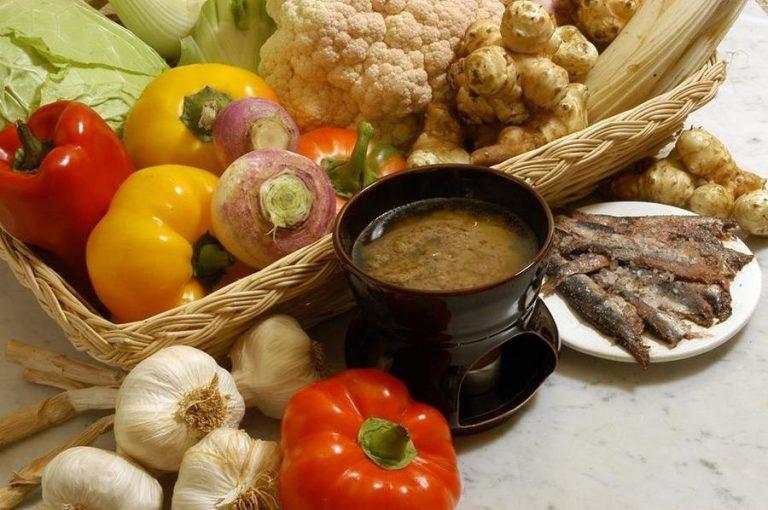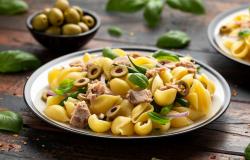A Convivial Dish for the Fall Season: Bagna Cauda from Piedmont
ITA:

Use player to listen to Italian version
Bagna cauda is a typical Piedmontese sauce prepared with anchovies, olive oil and garlic, used for dipping a variety of seasonal vegetables, both raw and cooked, and especially thistles, baked onions, raw or roasted peppers, raw cabbage leaves, cauliflower, Jerusalem artichokes, beetroot, steamed potatoes, radishes, turnips and more. The chopped garlic and anchovies are slow cooked in extra virgin olive oil, until they turn into a sauce.
Traditionally, it was a dish consumed during the harvest period, and still today it is typical of the fall and winter seasons; one of the stories about its origin says that it was prepared to reward grape pickers for the work done.
In reality, it is not known precisely when and who invented this dressing, but what is known is that it originated in Piedmont, where it was easy to find one of its key ingredients, anchovies.
For a long time, bagna cauda was enjoyed only by the poor; the aristocrats scorned the dish because of its abundance of garlic.
Today, bagna cauda features prominently on the menus of Piedmont’s restaurants and trattorias.
Being a hearty dish, it can work as a ‘piatto unico’ (main dish), but it is also often served as an appetizer for a dinner with friends.
As for the origin of the name, ‘bagna’ in Piedmont dialect means sauce, and ‘cauda’ or ‘caoda’ means warm, therefore warm sauce.
In fact, bagna cauda is served in the ‘fujot,’ a particular terracotta or copper container with a small flame underneath that keeps the sauce warm.
More than a dish, it is a convivial ritual; in the past, people dipped from a common container. Now, each diner tends to have his or her own.
Bagna càuda goes well with full-bodied red wines, such as Barbera, Nebbiolo, Barbaresco and Dolcetto.
La bagna cauda è una tipica salsa piemontese preparata con acciughe, olio d'oliva e aglio, utilizzata per intingere verdure di stagione, sia crude che cotte, ed in particolare cardi, cipolle al forno, peperoni crudi o arrostiti, foglie di cavolo crudo, cavolfiore, topinambur, barbabietole, patate al vapore, ravanelli, rape e altro ancora. L'aglio tritato e le acciughe vengono cotti lentamente in olio extra vergine di oliva, fino a trasformarsi in salsa.
Tradizionalmente, era un piatto consumato durante il periodo del raccolto, e ancora oggi è tipico delle stagioni autunnale e invernale; una delle leggende sulla sua origine racconta che era servito come ricompensa per il lavoro svolto ai vendemmiatori.
In realtà, non si sa con precisione quando e chi ha inventato questo condimento, ma si sa che è nato in Piemonte, dove era facile trovare uno dei suoi ingredienti chiave, le acciughe.
Per molto tempo, la bagna cauda è stata consumata solo dai poveri; gli aristocratici la disprezzavano per la sua abbondanza di aglio.
Oggi invece la bagna cauda è frequentissima nei menu di ristoranti e trattorie piemontesi.
Essendo un piatto sostanzioso, può fungere da ‘piatto unico’, ma spesso è anche servito come antipasto per una cena con gli amici.
Per quanto riguarda l'origine del nome, ‘bagna’ in dialetto piemontese significa salsa e ‘cauda’ o ‘caoda’ significa calda, dunque salsa calda.
In effetti, la bagna cauda viene servita nel ‘fujot,’ un particolare contenitore in terracotta o rame con una piccola fiamma sotto che la mantiene calda.
Più che un semplice piatto, la bagna cauda rappresenta un rito conviviale; in passato, le persone usavano intingere le verdure in un contenitore comune. Oggi, è più comune che ciascun commensale usi il proprio.
La bagna càuda si sposa bene con vini rossi corposi, come Barbera, Nebbiolo, Barbaresco e Dolcetto.











